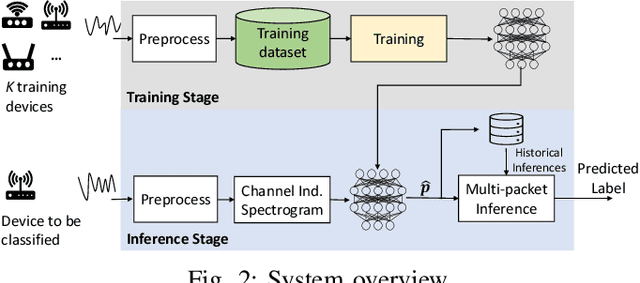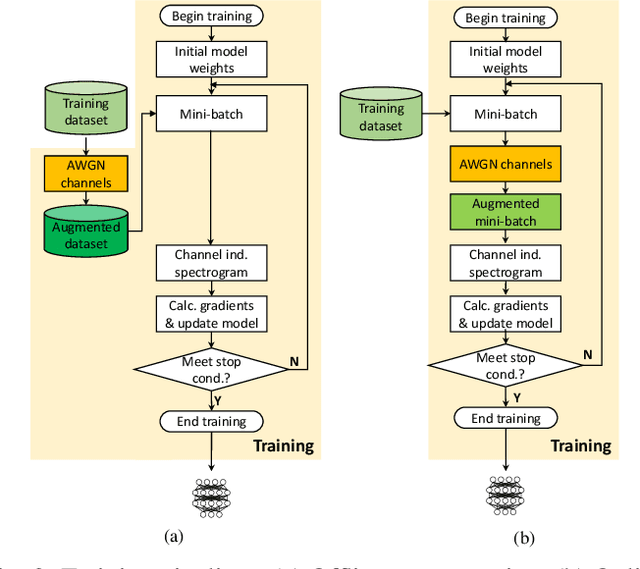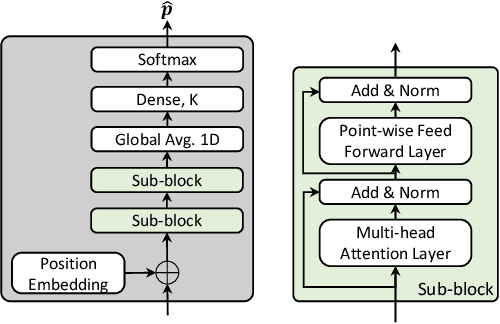Joseph Cavallaro
Towards Length-Versatile and Noise-Robust Radio Frequency Fingerprint Identification
Jul 06, 2022



Abstract:Radio frequency fingerprint identification (RFFI) can classify wireless devices by analyzing the signal distortions caused by the intrinsic hardware impairments. State-of-the-art neural networks have been adopted for RFFI. However, many neural networks, e.g., multilayer perceptron (MLP) and convolutional neural network (CNN), require fixed-size input data. In addition, many IoT devices work in low signal-to-noise ratio (SNR) scenarios but the RFFI performance in such scenarios is rarely investigated. In this paper, we analyze the reason why MLP- and CNN-based RFFI systems are constrained by the input size. To overcome this, we propose four neural networks that can process signals of variable lengths, namely flatten-free CNN, long short-term memory (LSTM) network, gated recurrent unit (GRU) network and transformer. We adopt data augmentation during training which can significantly improve the model's robustness to noise. We compare two augmentation schemes, namely offline and online augmentation. The results show the online one performs better. During the inference, a multi-packet inference approach is further leveraged to improve the classification accuracy in low SNR scenarios. We take LoRa as a case study and evaluate the system by classifying 10 commercial-off-the-shelf LoRa devices in various SNR conditions. The online augmentation can boost the low-SNR classification accuracy by up to 50% and the multi-packet inference approach can further increase the accuracy by over 20%.
Towards Receiver-Agnostic and Collaborative Radio Frequency Fingerprint Identification
Jul 06, 2022



Abstract:Radio frequency fingerprint identification (RFFI) is an emerging device authentication technique, which exploits the hardware characteristics of the RF front-end as device identifiers. RFFI is implemented in the wireless receiver and acts to extract the transmitter impairments and then perform classification. The receiver hardware impairments will actually interfere with the feature extraction process, but its effect and mitigation have not been comprehensively studied. In this paper, we propose a receiver-agnostic RFFI system that is not sensitive to the changes in receiver characteristics; it is implemented by employing adversarial training to learn the receiver-independent features. Moreover, when there are multiple receivers, this functionality can perform collaborative inference to enhance classification accuracy. Finally, we show how it is possible to leverage fine-tuning for further improvement with fewer collected signals. To validate the approach, we have conducted extensive experimental evaluation by applying the approach to a LoRaWAN case study involving ten LoRa devices and 20 software-defined radio (SDR) receivers. The results show that receiver-agnostic training enables the trained neural network to become robust to changes in receiver characteristics. The collaborative inference improves classification accuracy by up to 20% beyond a single-receiver RFFI system and fine-tuning can bring a 40% improvement for under-performing receivers.
Radio Frequency Fingerprint Identification for Security in Low-Cost IoT Devices
Nov 28, 2021



Abstract:Radio frequency fingerprint identification (RFFI) can uniquely classify wireless devices by analyzing the received signal distortions caused by the intrinsic hardware impairments. The state-of-the-art deep learning techniques such as convolutional neural network (CNN) have been adopted to classify IoT devices with high accuracy. However, deep learning-based RFFI requires input data of a fixed size. In addition, many IoT devices work in low signal-to-noise ratio (SNR) scenarios but the low SNR RFFI is rarely investigated. In this paper, the state-of-the-art transformer model is used as the classifier, which can process signals of variable length. Data augmentation is adopted to improve low SNR RFFI performance. A multi-packet inference approach is further proposed to improve the classification accuracy in low SNR scenarios. We take LoRa as a case study and evaluate the system by classifying 10 commercial-off-the-shelf LoRa devices in various SNR conditions. The online augmentation can boost the low SNR RFFI performance by up to 50% and multi-packet inference can further increase it by over 20%.
RT-RCG: Neural Network and Accelerator Search Towards Effective and Real-time ECG Reconstruction from Intracardiac Electrograms
Nov 04, 2021



Abstract:There exists a gap in terms of the signals provided by pacemakers (i.e., intracardiac electrogram (EGM)) and the signals doctors use (i.e., 12-lead electrocardiogram (ECG)) to diagnose abnormal rhythms. Therefore, the former, even if remotely transmitted, are not sufficient for doctors to provide a precise diagnosis, let alone make a timely intervention. To close this gap and make a heuristic step towards real-time critical intervention in instant response to irregular and infrequent ventricular rhythms, we propose a new framework dubbed RT-RCG to automatically search for (1) efficient Deep Neural Network (DNN) structures and then (2)corresponding accelerators, to enable Real-Time and high-quality Reconstruction of ECG signals from EGM signals. Specifically, RT-RCG proposes a new DNN search space tailored for ECG reconstruction from EGM signals, and incorporates a differentiable acceleration search (DAS) engine to efficiently navigate over the large and discrete accelerator design space to generate optimized accelerators. Extensive experiments and ablation studies under various settings consistently validate the effectiveness of our RT-RCG. To the best of our knowledge, RT-RCG is the first to leverage neural architecture search (NAS) to simultaneously tackle both reconstruction efficacy and efficiency.
Towards Scalable and Channel-Robust Radio Frequency Fingerprint Identification for LoRa
Jul 06, 2021Abstract:Radio frequency fingerprint identification (RFFI) is a promising device authentication technique based on the transmitter hardware impairments. In this paper, we propose a scalable and robust RFFI framework achieved by deep learning powered radio frequency fingerprint (RFF) extractor. Specifically, we leverage the deep metric learning to train an RFF extractor, which has excellent generalization ability and can extract RFFs from previously unseen devices. Any devices can be enrolled via the pre-trained RFF extractor and the RFF database can be maintained efficiently for allowing devices to join and leave. Wireless channel impacts the RFF extraction and is tackled by exploiting channel independent feature and data augmentation. We carried out extensive experimental evaluation involving 60 commercial off-the-shelf LoRa devices and a USRP N210 software defined radio platform. The results have successfully demonstrated that our framework can achieve excellent generalization abilities for device classification and rogue device detection as well as effective channel mitigation.
 Add to Chrome
Add to Chrome Add to Firefox
Add to Firefox Add to Edge
Add to Edge